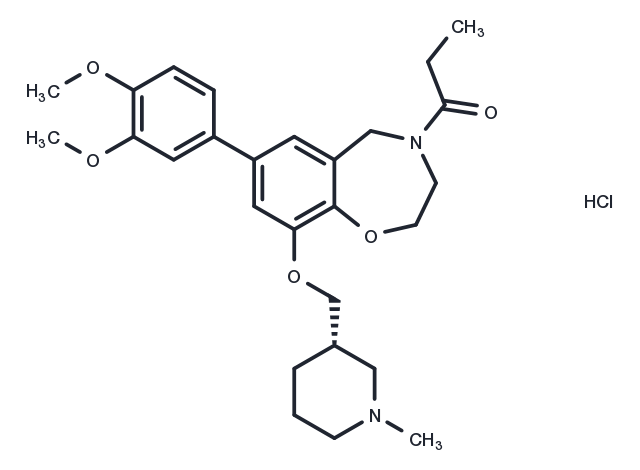Powder: -20°C for 3 years | In solvent: -80°C for 1 year


I-CBP112 is a selective inhibitor of the bromodomain-containing transcription factors. I-CBP112 (1 mM) has little activity against other bromodomains. I-CBP112 targets the CBP/p300 bromodomains. I-CBP112 significantly reduced the leukemia-initiating potential of MLL-AF9(+) acute myeloid leukemia cells in a dose-dependent manner in vitro and in vivo. Interestingly, I-CBP112 increased the cytotoxic activity of BET bromodomain inhibitor JQ1 as well as doxorubicin.

| Pack Size | Availability | Price/USD | Quantity |
|---|---|---|---|
| 1 mg | In stock | $ 83.00 | |
| 2 mg | In stock | $ 148.00 | |
| 5 mg | In stock | $ 249.00 | |
| 10 mg | In stock | $ 471.00 | |
| 25 mg | In stock | $ 773.00 | |
| 50 mg | In stock | $ 1,080.00 | |
| 100 mg | In stock | $ 1,460.00 | |
| 1 mL * 10 mM (in DMSO) | In stock | $ 471.00 |


| Description | I-CBP112 is a selective inhibitor of the bromodomain-containing transcription factors. I-CBP112 (1 mM) has little activity against other bromodomains. I-CBP112 targets the CBP/p300 bromodomains. I-CBP112 significantly reduced the leukemia-initiating potential of MLL-AF9(+) acute myeloid leukemia cells in a dose-dependent manner in vitro and in vivo. Interestingly, I-CBP112 increased the cytotoxic activity of BET bromodomain inhibitor JQ1 as well as doxorubicin. |
| In vitro | I-CBP112 markedly increases acetylation by p300 at the histone H3K18 and H3K23 sites. I-CBP112 stimulated H3K18ac by ~3-fold, and induced enhances acetylation of these same sites by CBP as well as at H4K5. The EC50s of activation of I-CBP112 on CBP- and p300-mediated H3K18 acetylation are ~2 μM[1]. In mouse and human leukemia cell lines, I-CBP112 causes substantially impaired colony formation and induces cellular differentiation without significant cytotoxicity. In BioMAP primary cell panel, I-CBP112 results in a unique response on cytokine and marker protein expression[2]. |
| In vivo | I-CBP112 markedly and dose-dependently reduces the leukemia-initiating potential of mLL-AF9+ AmL cells in vitro and in vivo. The synergistic effects of I-CBP112 and current standard therapy (doxorubicin), as well as emerging treatment strategies (BET inhibition), provide new possibilities for combinatorial treatment of leukemia and potentially other cancers[2]. |
| Molecular Weight | 505.05 |
| Formula | C27H37ClN2O5 |
| CAS No. | 2147701-33-3 |
Powder: -20°C for 3 years | In solvent: -80°C for 1 year
DMSO: 60 mg/mL (118.8 mM)
You can also refer to dose conversion for different animals. More
bottom
Please see Inhibitor Handling Instructions for more frequently ask questions. Topics include: how to prepare stock solutions, how to store products, and cautions on cell-based assays & animal experiments, etc.
I-CBP112 hydrochloride 2147701-33-3 Chromatin/Epigenetic Epigenetic Reader Domain inhibit Inhibitor I CBP112 hydrochloride I-CBP 112 Hydrochloride I-CBP-112 hydrochloride I-CBP112 I-CBP112 Hydrochloride I-CBP-112 Hydrochloride ICBP112 hydrochloride inhibitor
